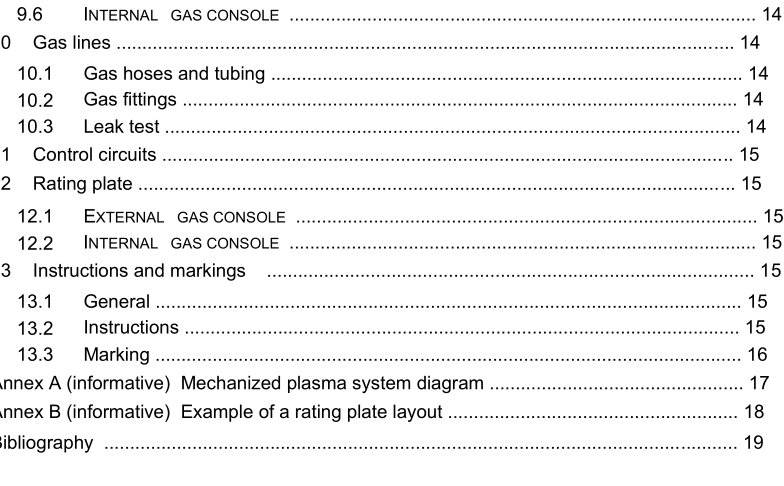IEC 60974-8-2021 pdf Arc welding equipment – Part 8: Gas consoles for welding and plasma cutting systems

7.3 Limits of temperature rise As specified in 7.3 of IEC 60974-1:2017. Additionally, the temperature of surfaces exposed to combustible gases shall be at least 20 % cooler than the ignition temperature of any combustible gas intended to be used in the GAS CONSOLE . Conformity shall be checked by operating the GAS CONSOLE at the maximum specified ambient temperature and system duty cycle, while monitoring the inside of the gas console with an IR camera for temperatures exceeding the 20 % margin of the ignition temperature of any combustible gas intended to be used in the GAS CONSOLE . a) with the combinations of gas(es) and flow rates which creates the worst-case condition, as specified by the manufacturer; b) with the cooling liquid as specified by the manufacturer. 8 Connections for plasma cutting torches As specified in 11.4.6 of IEC 60974-1:2017, where the torch connects to the GAS CONSOLE . 9 Mechanical provisions General 9.1 As specified in Clause 14 of IEC 60974-1:2017, with the following additions. 9.2 Protection against fire or explosion The GAS CONSOLE shall be designed to prevent fire or explosion under normal operating conditions and under a SINGLE – FAULT CONDITION (for example, defective valve, hose, etc.). Where a GAS CONSOLE uses a combustible gas, any circuit, subassembly, or component shall not be capable of creating temperatures or a spark with sufficient energy to cause an ignition. A GAS CONSOLE using combustible gas in a mixture shall not allow the concentration of mixture to be between the LFL and UFL. Conformity shall be checked by: a) design evaluation and calculations of the circuits, subassembly, or component verification; or b) applying a fault (for example, open circuit, short circuit, and/or restriction of movement) to the circuits, subassembly, or component until an event occurs (for example, a spark which does not cause ignition, fuse opens, unit shuts down, etc.) or a steady-state temperature is achieved.
- ISO IEC 27050-4-2021 pdf Information technology — Electronic discovery — Part 4: Technical readiness
- ISO IEC 27036-1-2021 pdf Cybersecurity — Supplier relationships — Part 1: Overview and concepts
- ISO IEC 27013-2021 pdf Information security, cybersecurity and privacy protection — Guidance on the integrated implementation of ISO/IEC 27001 and ISO/IEC 20000-1
- ISO IEC 26580-2021 pdf Software and systems engineering — Methods and tools for the feature- based approach to software and systems product line engineering
- ISO IEC 24735-2021 pdf Information technology — Office equipment — Method for measuring digital copying productivity
- ISO IEC 24711-2021 pdf Information technology — Office equipment — Method for the determination of ink cartridge yield for colour inkjet printers and multi- function devices that contain printer components
- ISO IEC 23544-2021 pdf Information Technology — Data centres — Application Platform Energy Effectiveness (APEE)
- ISO IEC 23510-2021 pdf Information technology — 3D printing and scanning — Framework for an Additive Manufacturing Service Platform (AMSP)
- ISO IEC 23127-1-2021 pdf Information technology — Learning, education, and training — Metadata for facilitators of online learning — Part 1: Framework
- ISO IEC 23126-2021 pdf Information technology for learning, education and training — Ubiquitous learning resource organization and description framework
- IEC 60974-8-2021 pdf Arc welding equipment – Part 8: Gas consoles for welding and plasma cutting systems
- IEC 60305-2021 pdf Insulators for overhead lines with a nominal voltage above 1 000 V – Ceramic or glass insulator units for AC systems – Characteristics of insulator units of the cap and pin type
- IEC 61386-23-2021 pdf Conduit systems for cable management – Part 23: Particular requirements – Flexible conduit systems
- IEC TR 63250-2021 pdf Household and similar electrical appliances – Method of measuring performance – Assessment of repeatability, reproducibility and uncertainty
- IEC 60196-2009 pdf IEC standard frequencies
- BS ISO IEC 15420-2009 pdf Information technology一 Automatic identification and data capture techniques EAN/UPC bar code symbology specification
- BS ISO IEC 19762.5-2008 pdf Information technology一 Automatic identification and data capture (AIDC) techniques – Harmonized vocabulary Part 5: Locating systems
- BS IEC 60860-2014 pdf Radiation protection instrumentation一 Warning equipment for criticality accidents
- ISO IEC 24735-2021 pdf Information technology — Office equipment — Method for measuring digital copying productivity
- ISO IEC 24711-2021 pdf Information technology — Office equipment — Method for the determination of ink cartridge yield for colour inkjet printers and multi- function devices that contain printer components